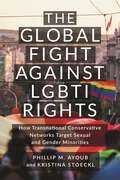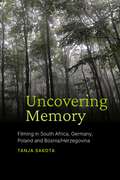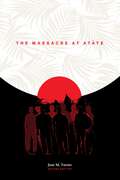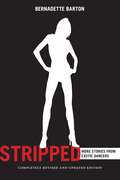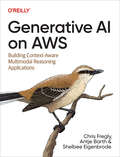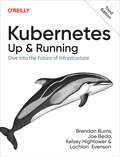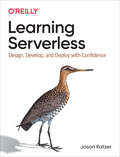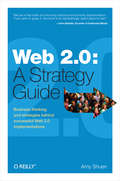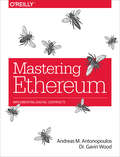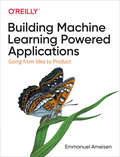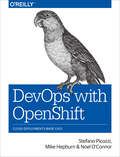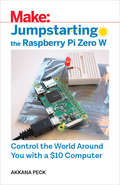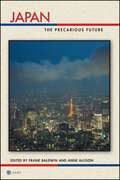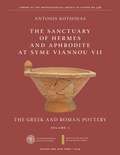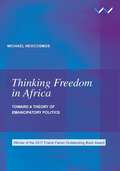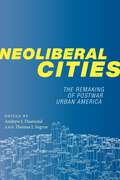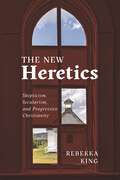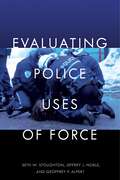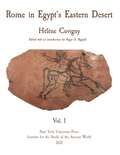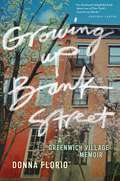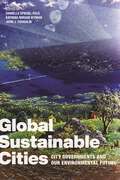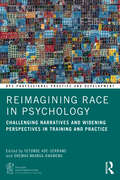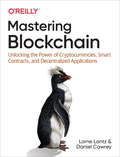- Table View
- List View
The Global Fight Against LGBTI Rights: How Transnational Conservative Networks Target Sexual and Gender Minorities (LGBTQ Politics)
by Phillip M. Ayoub Kristina StoecklAn in-depth look at the global movement to curtail LGBTI rights—and how the LGBTI movement responds to itIn the past three decades, remarkable progress has been made in numerous countries for the rights of individuals marginalized due to their sexual orientation and gender identity. The advancements in LGBTI rights can largely be attributed to the tireless efforts of the transnational LGBTI-rights movement, forward-thinking governments in pioneering nations, and the evolving human rights frameworks of international organizations. However, this journey towards equality has been met with formidable opposition. An increasingly interconnected and globally networked resistance, backed by religious-nationalist elements and conservative governments, has emerged to challenge LGBTI and women's rights, even seeking to reinterpret and co-opt international human rights law.In The Global Fight Against LGBTI Rights, authors Phillip M. Ayoub and Kristina Stoeckl investigate this complex landscape, drawing from over a decade of in-depth fieldwork and over 240 interviews with LGBTI activists, anti-LGBTI proponents, and various state and international organization actors. The authors explore the mechanisms and strategies employed by the conservative transnational movement, seeking to understand its composition and the construction of its agenda.With a wealth of empirical evidence and insightful analysis, this book is a valuable resource for scholars, policymakers, activists, and anyone interested in understanding the ongoing global battle for LGBTI rights.
Uncovering Memory: Filming in South Africa, Germany, Poland and Bosnia/Herzegovina
by Tanja SakotaMy interest in site-specific research is not random. My mother escaped through the sewers of Breslau, Germany in 1945 (today known as Wroclaw, Poland). My father was born in a country that no longer exists. Their final destination was Johannesburg, South Africa. This is where I enter the narrative. I was born during apartheid and my interest in memory and identity is a result of my historical and political context.’Each one of us comes with a history, a complex web of DNA and a library of information that shapes who we are and how we view the world. How can we use our own complexities not only to engage with one another but to build it for story content? As an artistic researcher, filmmaker and educator, Tanja Sakota has often thought how to bring this subjective experience into pedagogical practice. Using paired themes of memory and forgetting, segregation and migration, perpetrators and victims, Sakota travels along a timeline of memory as she takes us on a journey through South Africa, Germany, Poland and Bosnia/Herzegovina. Using a camera and short film techniques, she hosts several workshops focused on interacting and engaging with remembering through different memory sites. The author sits at the core but the book is an interdisciplinary work shaped around films made by different participants using the camera to access and unveil personal interpretations of space and place. Questions that underpin the uncovering of memories are: How does one use a camera to unmask invisible memories hidden within sites? How does one remember events that one hasn’t necessarily experienced? How does one use film to interrogate the past from the future present? As the journey evolves, workshop participants and readers alike enter into a conversation around practice-based research, autoethnography and film.Uncovering Memory is not a handbook offering a prescriptive method. Instead, it is a pedagogical text that offers an interactive approach for students and peers to consider, adapt or react to in their own teaching and learning practices. The narrative encourages readers to self-reflect as they explore their own memory using the camera and short film format as an engaging tool for research and knowledge production.
The Massacre at Atåte, 2nd Edition
by Jose M. TorresTorres' story of courage, endurance and heroism in 'The Massacre at Atåte'The Massacre at Atåte tells the story of the courageous people of the idyllic southern village of Malesso' in Guam, who liberated themselves from the violent occupation of their village by Japanese forces during World War II. After scores of their relatives were killed in two massacres, a group of CHamoru men rose up in a littleknown place called Atåte, where they fought and massacred the Japanese to protect their families. The book includes an introduction by Guam’s former Representative to U.S. Congress Dr. Robert A. Underwood, and an afterword by Guam Historian Dr. Michael Lujan Bevacqua.
Stripped, 2nd Edition: More Stories from Exotic Dancers
by Bernadette BartonWhatkind of woman dances naked for money? Bernadette Barton takes us insidecountless strip bars and clubs, from upscale to back road as well as those thatspecialize in lap dancing, table dancing, topless only, and peep shows, toreveal the startling lives of exotic dancers. Originally published in 2006, the product of years of first-hand research in strip clubs around the country, Stripped is a classic portrait of what it’s like for those who choose to strip as a profession. Barton explores why women begin stripping, the initial excitement and financial rewards of the work, the dangers of the life—namely, drugs and prostitution—and, inevitably, the difficulties in staying in the business over time, especially for their relationships, sexuality and self-esteem. In this completely revised and updated edition, Barton returns to the strip clubs she originally studied to observe the major changes in the industry that have occurred over the last decade. She examines how “raunch culture” affects exotic dancers’ treatment by their clientele, who are now accustomed to seeing nudity and sexualized performance in accessible, R and X -rated media from a variety of outlets, particularly the Internet. Barton explores how new media has transformed exotic dancing, allowing dancers to build an online brand, but also introducing possibilities for customers to take unauthorized nude photos and videos of the entertainers.. And finally, Barton speaks to new dancers as well as dancers she interviewed in the previous edition, examining how the toll of stripping still impacts the lives of exotic dancers in a changing industry. Incorporating new scholarship, new observations, and increased awareness of emerging media technology, Barton brings a fresh and important perspective on the challenges that women face working in the still-thriving world of exotic dancing.
Generative AI on AWS: Building Context-Aware Multimodal Reasoning Applications
by Chris Fregly Antje Barth Shelbee EigenbrodeCompanies today are moving rapidly to integrate generative AI into their products and services. But there's a great deal of hype (and misunderstanding) about the impact and promise of this technology. With this book, Chris Fregly, Antje Barth, and Shelbee Eigenbrode from AWS help CTOs, ML practitioners, application developers, business analysts, data engineers, and data scientists find practical ways to use this exciting new technology.You'll learn the generative AI project life cycle including use case definition, model selection, model fine-tuning, retrieval-augmented generation, reinforcement learning from human feedback, and model quantization, optimization, and deployment. And you'll explore different types of models including large language models (LLMs) and multimodal models such as Stable Diffusion for generating images and Flamingo/IDEFICS for answering questions about images.Apply generative AI to your business use casesDetermine which generative AI models are best suited to your task Perform prompt engineering and in-context learningFine-tune generative AI models on your datasets with low-rank adaptation (LoRA)Align generative AI models to human values with reinforcement learning from human feedback (RLHF)Augment your model with retrieval-augmented generation (RAG)Explore libraries such as LangChain and ReAct to develop agents and actionsBuild generative AI applications with Amazon Bedrock
Kubernetes: Dive into the Future of Infrastructure
by Kelsey Hightower Brendan Burns Joe Beda Lachlan EvensonIn just five years, Kubernetes has radically changed the way developers and ops personnel build, deploy, and maintain applications in the cloud. With this book's updated third edition, you'll learn how this popular container orchestrator can help your company achieve new levels of velocity, agility, reliability, and efficiency--whether you're new to distributed systems or have been deploying cloud native apps for some time.Brendan Burns, Joe Beda, Kelsey Hightower, and Lachlan Evenson--who have worked on Kubernetes at Google and beyond--explain how this system fits into the life cycle of a distributed application. Software developers, engineers, and architects will learn ways to use tools and APIs to automate scalable distributed systems for online services, machine learning applications, or even a cluster of Raspberry Pi computers.This guide shows you how to:Create a simple cluster to learn how Kubernetes worksDive into the details of deploying an application using KubernetesLearn specialized objects in Kubernetes, such as DaemonSets, jobs, ConfigMaps, and secretsExplore deployments that tie together the lifecycle of a complete applicationGet practical examples of how to develop and deploy real-world applications in Kubernetes
Learning Serverless: Design, Develop, And Deploy With Confidence
by Jason KatzerWhether your company is considering serverless computing or has already made the decision to adopt this model, this practical book is for you. Author Jason Katzer shows early and mid-career developers what's required to build and ship maintainable and scalable services using this model.With this book, you'll learn how to build a modern production system in the cloud, viewed through the lens of serverless computing. You'll discover how serverless can free you from the tedious task of setting up and maintaining systems in production. You'll also explore new ways to level up your careerand design, develop, and deploy with confidence.In three parts, this book includes:The Path to Production: Examine the ins and outs of distributed systems, microservices, interfaces, and serverless architecture and patternsThe Tools: Dive into monitoring, observability and alerting, logging, pipelines, automation, and deploymentConcepts: Learn how to design security and privacy, how to manage quality through testing and staging, and how to plan for failure
Web 2.0: Business Thinking and Strategies Behind Successful Web 2.0 Implementations
by Amy ShuenWeb 2.0 makes headlines, but how does it make money? This concise guide explains what's different about Web 2.0 and how those differences can improve your company's bottom line. Whether you're an executive plotting the next move, a small business owner looking to expand, or an entrepreneur planning a startup, Web 2.0: A Strategy Guide illustrates through real-life examples how businesses, large and small, are creating new opportunities on today's Web.This book is about strategy. Rather than focus on the technology, the examples concentrate on its effect. You will learn that creating a Web 2.0 business, or integrating Web 2.0 strategies with your existing business, means creating places online where people like to come together to share what they think, see, and do. When people come together over the Web, the result can be much more than the sum of the parts. The customers themselves help build the site, as old-fashioned "word of mouth" becomes hypergrowth.Web 2.0: A Strategy Guide demonstrates the power of this new paradigm by examining how: Flickr, a classic user-driven business, created value for itself by helping users create their own valueGoogle made money with a model based on free search, and changed the rules for doing business on the Web-opening opportunities you can take advantage ofSocial network effects can support a business-ever wonder how FaceBook grew so quickly?Businesses like Amazon tap into the Web as a source of indirect revenue, using creative new approaches to monetize the investments they've made in the WebWritten by Amy Shuen, an authority on Silicon Valley business models and innovation economics, Web 2.0: A Strategy Guide explains how to transform your business by looking at specific practices for integrating Web 2.0 with what you do. If you're executing business strategy and want to know how the Web is changing business, this book is for you.
Mastering Ethereum: Building Smart Contracts and DApps
by Andreas M. Antonopoulos Gavin WoodEthereum represents the gateway to a worldwide, decentralized computing paradigm. This platform enables you to run decentralized applications (DApps) and smart contracts that have no central points of failure or control, integrate with a payment network, and operate on an open blockchain. With this practical guide, Andreas M. Antonopoulos and Gavin Wood provide everything you need to know about building smart contracts and DApps on Ethereum and other virtual-machine blockchains.Discover why IBM, Microsoft, NASDAQ, and hundreds of other organizations are experimenting with Ethereum. This essential guide shows you how to develop the skills necessary to be an innovator in this growing and exciting new industry.Run an Ethereum client, create and transmit basic transactions, and program smart contractsLearn the essentials of public key cryptography, hashes, and digital signaturesUnderstand how "wallets" hold digital keys that control funds and smart contractsInteract with Ethereum clients programmatically using JavaScript libraries and Remote Procedure Call interfacesLearn security best practices, design patterns, and anti-patterns with real-world examplesCreate tokens that represent assets, shares, votes, or access control rightsBuild decentralized applications using multiple peer-to-peer (P2P) components
Fluent React: Build Fast, Performant, and Intuitive Web Applications
by Tejas KumarWhen it comes to building user interfaces on the web, React enables web developers to unlock a new world of possibilities. This practical book helps you take a deep dive into fundamental concepts of this JavaScript library, including JSX syntax and advanced patterns, the virtual DOM, React reconciliation, and advanced optimization techniques. By becoming fluent in React, you'll quickly learn how to build better web applications.Author Tejas Kumar helps you explore the depths of React in plain English, without the typical software engineering jargon, so you can more easily understand how this JavaScript library works. You'll learn how to write intuitive React code that fully understands the nuances and layers of React, unlocking a whole new level of fluency.You will:Understand how React works at a deeper levelWrite React apps while optimizing them along the wayBuild resilient React applications that work well at arbitrary scaleCreate React applications for other platforms adjacent to the web and mobile devicesKnow when to reach for different mechanisms exposed by React, such as reducers versus state versus refs
Building Machine Learning Powered Applications: Going from Idea to Product
by Emmanuel AmeisenLearn the skills necessary to design, build, and deploy applications powered by machine learning (ML). Through the course of this hands-on book, you’ll build an example ML-driven application from initial idea to deployed product. Data scientists, software engineers, and product managers—including experienced practitioners and novices alike—will learn the tools, best practices, and challenges involved in building a real-world ML application step by step.Author Emmanuel Ameisen, an experienced data scientist who led an AI education program, demonstrates practical ML concepts using code snippets, illustrations, screenshots, and interviews with industry leaders. Part I teaches you how to plan an ML application and measure success. Part II explains how to build a working ML model. Part III demonstrates ways to improve the model until it fulfills your original vision. Part IV covers deployment and monitoring strategies.This book will help you:Define your product goal and set up a machine learning problemBuild your first end-to-end pipeline quickly and acquire an initial datasetTrain and evaluate your ML models and address performance bottlenecksDeploy and monitor your models in a production environment
DevOps with OpenShift: Cloud Deployments Made Easy
by Mike Hepburn Noel O'Connor Stefano PicozziFor many organizations, a big part of DevOps’ appeal is software automation using infrastructure-as-code techniques. This book presents developers, architects, and infra-ops engineers with a more practical option. You’ll learn how a container-centric approach from OpenShift, Red Hat’s cloud-based PaaS, can help your team deliver quality software through a self-service view of IT infrastructure.Three OpenShift experts at Red Hat explain how to configure Docker application containers and the Kubernetes cluster manager with OpenShift’s developer- and operational-centric tools. Discover how this infrastructure-agnostic container management platform can help companies navigate the murky area where infrastructure-as-code ends and application automation begins.Get an application-centric view of automation—and understand why it’s importantLearn patterns and practical examples for managing continuous deployments such as rolling, A/B, blue-green, and canaryImplement continuous integration pipelines with OpenShift’s Jenkins capabilityExplore mechanisms for separating and managing configuration from static runtime softwareLearn how to use and customize OpenShift’s source-to-image capabilityDelve into management and operational considerations when working with OpenShift-based application workloadsInstall a self-contained local version of the OpenShift environment on your computer
Jumpstarting the Raspberry Pi Zero W
by Akkana PeckGet up and running quickly with the new Jumpstarting ebook series from Make:. The super-small $10 Raspberry Pi Zero W includes wireless LAN and Bluetooth connectivity and is 40% faster than the original Raspberry Pi.
Japan: The Precarious Future (Possible Futures #1)
by Frank Baldwin Anne AllisonOn March 11, 2011, a 9.0 earthquake off Japan’s northeast coast triggered a tsunami that killed more than 20,000 people, displaced 600,000, and caused billions of dollars in damage as well as a nuclear meltdown of three reactors at the Fukushima Daiichi nuclear plant. Japan, the world’s third largest economy, was already grappling with recovery from both its own economic recession of the 1990s and the global recession following the US-driven financial crisis of 2008 when the disaster hit, changing its fortunes yet again. This small, populous Asian nation—once thought to be a contender for the role of the world’s number one power—now faces a world of uncertainty. Japan’s economy has shrunk, China has challenged its borders, and it faces perilous demographic adjustments from decreased fertility and an aging populace, with the country’s population expected to drop to less than 100 million by 2048. In Japan: The Precarious Future, a group of distinguished scholars of Japanese economics, politics, law, and society examine the various roads that might lie ahead. Will Japan face a continued erosion of global economic and political power, particularly as China’s outlook improves exponentially? Or will it find a way to protect its status as an important player in global affairs? Contributors explore issues such as national security, political leadership, manufacturing prowess, diplomacy, population decline, and gender equality in politics and the workforce, all in an effort to chart the possible futures for Japan. Both a roadmap for change and a look at how Japan arrived at its present situation, this collection of thought-provoking analyses will be essential for understanding the current landscape and future prospects of this world power.
The Sanctuary of Hermes and Aphrodite at Syme Viannou VII, Vol. 1: The Greek and Roman Pottery (ISAW Monographs)
by Antonis KotsonasNew insights from the archaeology and pottery of the sanctuary of Hermes and Aphrodite at Syme Viannou, Crete The Sanctuary of Hermes and Aphrodite at Syme Viannou VII: The Greek and Roman Pottery presents in two volumes the Greek and Roman pottery recovered from the excavation of the sanctuary of Syme Viannou, one of the most long-lived and important cult sites of ancient Crete and the Aegean. The site, which is known as the Cretan Delphi, was dedicated to Hermes and Aphrodite for much of its history. The present study analyzes and catalogs 865 pieces, dating from across the early first millennium BCE to the mid-first millennium CE. Kotsonas integrates traditional typological and chronological inquiries with contextual considerations, macroscopic and petrographic analyses of ceramic fabrics, and quantitative studies. The resulting work provides detailed documentation of the pottery from Syme Viannou and explores its ritual and other roles within the diachronic panorama of cultic and other activities at the site. It also supports a broader understanding of the role of ceramics in sanctuary contexts by introducing systematically comparative perspectives on the evidence of pottery from other Cretan and Greek sanctuaries.Volume 1 provides an introduction to the site of the sanctuary of Syme Viannou and its history, and contains an analytical catalog of the ceramic remains.
Thinking Freedom in Africa: Toward a theory of emancipatory politics
by Michael NeocosmosThinking Freedom in Africa conceives an emancipatory politics beginning from the axiom that ‘people think’. Previous ways of conceiving the universal emancipation of humanity have in practice ended in failure. Marxism, anti-colonial nationalism and neo-liberalism all understand the achievement of universal emancipation through a form of state politics. Marxism, which had encapsulated the idea of freedom for most of the twentieth century, was found wanting when it came to thinking emancipation because social interests and identities were understood as simply reflected in political subjectivity which could only lead to statist authoritarianism. Neo-liberalism and anti-colonial nationalism have also both assumed that freedom is realizable through the state, and have been equally authoritarian in their relations to those they have excluded on the African continent and elsewhere.Thinking Freedom in Africa then conceives emancipatory politics beginning from the axiom that ‘people think’. In other words, the idea that anyone is capable of engaging in a collective thought-practice which exceeds social place, interests and identities and which thus begins to think a politics of universal humanity. Using the work of thinkers such as Alain Badiou, Jacques Rancière, Sylvain Lazarus, Frantz Fanon and many others, along with the inventive thought of people themselves in their experiences of struggle, the author proceeds to analyse how Africans themselves – with agency of their own – have thought emancipation during various historical political sequences and to show how emancipation may be thought today in a manner appropriate to twenty-first century conditions and concerns.
Neoliberal Cities: The Remaking of Postwar Urban America (NYU Series in Social and Cultural Analysis #9)
by Thomas J. Sugrue Andrew J. DiamondTraces decades of troubled attempts to fund private answers to public urban problemsThe American city has long been a laboratory for austerity, governmental decentralization, and market-based solutions to urgent public problems such as affordable housing, criminal justice, and education. Through richly told case studies from Boston, Chicago, Cleveland, Los Angeles, New Orleans, and New York, Neoliberal Cities provides the necessary context to understand the always intensifying racial and economic inequality in and around the city center. In this original collection of essays, urban historians and sociologists trace the role that public policies have played in reshaping cities, with particular attention to labor, the privatization of public services, the collapse of welfare, the rise of gentrification, the expansion of the carceral state, and the politics of community control. In so doing, Neoliberal Cities offers a bottom-up approach to social scientific, theoretical, and historical accounts of urban America, exploring the ways that activists and grassroots organizations, as well as ordinary citizens, came to terms with new market-oriented public policies promoted by multinational corporations, financial institutions, and political parties. Neoliberal Cities offers new scaffolding for urban and metropolitan change, with attention to the interaction between policymaking, city planning, social movements, and the market.
The New Heretics: Skepticism, Secularism, and Progressive Christianity
by Rebekka KingCharts the development of progressive Christianity’s engagement with modern science, historical criticism, and liberal humanismChristians who have doubts about the existence of God? Who do not believe in the divinity of Jesus? Who reject the accuracy of the Bible? The New Heretics explores the development of progressive Christianity, a movement of Christians who do not reject their identity as Christians, but who believe Christianity must be updated for today’s times and take into consideration modern science, historical criticism, and liberal humanism.Drawing on three years of ethnographic fieldwork in North America, Rebekka King focuses on testimonies of deconversion, collective reading practices, and the ways in which religious beliefs and practices are adapted to fit secular lives. King introduces the concept of “lived secularity” as a category with which to examine the ways in which religiosity often is entangled with and subsumed by secular identities over and against religious ones. This theoretical framework provides insight into the study of religious and cultural hybridity, new emerging groups such as “the nones,” atheism, religious apostasy, and multi-religious identities. The New Heretics pays close attention to the ways that progressive Christians understand themselves vis-à-vis a conservative or fundamentalist Christian “other,” providing context concerning the presumed divide between the religious right and the religious left. King shows that while it might be tempting to think of progressive Christians as atheists, there are religious and moral dimensions to their disbelief. For progressive Christians the act of questioning and rejecting God—alongside other theological tenets—is framed as a moral activity. Ultimately, the book showcases the importance of engaging with the ethics of belief in understanding contemporary Christianity.
Evaluating Police Uses of Force
by Seth W. Stoughton Jeffrey J. Noble Geoffrey P. AlpertProvides a critical understanding and evaluation of police tactics and the use of forcePolice violence has historically played an important role in shaping public attitudes toward the government. Community trust and confidence in policing have been undermined by the perception that officers are using force unnecessarily, too frequently, or in problematic ways. The use of force, or harm suffered by a community as a result of such force, can also serve as a flashpoint, a spark that ignites long-simmering community hostility.In Evaluating Police Uses of Force, legal scholar Seth W. Stoughton, former deputy chief of police Jeffrey J. Noble, and distinguished criminologist Geoffrey P. Alpert explore a critical but largely overlooked facet of the difficult and controversial issues of police violence and accountability: how does society evaluate use-of-force incidents? By leading readers through answers to this question from four different perspectives—constitutional law, state law, administrative regulation, and community expectations—and by providing critical information about police tactics and force options that are implicated within those frameworks, Evaluating Police Uses of Force helps situate readers within broader conversations about governmental accountability, the role that police play in modern society, and how officers should go about fulfilling their duties.
Rome in Egypt's Eastern Desert: Volume One (ISAW Monographs)
by Hélène CuvignyA detailed archaeological study of life in Egypt's Eastern desert during the Roman period by a leading scholarRome in Egypt’s Eastern Desert is a two-volume set collecting Hélène Cuvigny’s most important articles on Egypt’s Eastern Desert during the Roman period. The excavations she directed uncovered a wealth of material, including tens of thousands of texts written on pottery fragments (ostraca). Some are administrative texts, but many more are correspondence, both official and private, written by and to the people (mostly but not all men) who lived and worked in these remote and harsh environments, supported by an elaborate network of defense, administration, and supply that tied the entire region together. The contents of Rome in Egypt’s Eastern Desert have all been published earlier in peer-reviewed venues, but most appear here for the first time in English. All of the contributions have been checked or translated by the editor and brought up to date with respect to bibliography, and some have been significantly rewritten by the author, in order to take account of the enormous amount of new material discovered since the original publications. A full index makes this body of work far more accessible than it was before. This book assembles into one collection thirty years of detailed study of this material, conjuring in vivid detail the lived experience of those who inhabited these forts—often through their own expressive language—and the realia of desert geography, military life, sex, religion, quarry operations, and imperial administration in the Roman world.
Growing Up Bank Street: A Greenwich Village Memoir (Washington Mews Books)
by Donna FlorioA vivid memoir of life in one of New York City’s most dynamic neighborhoodsGrowing Up Bank Street is an evocative, tender account of life in Greenwich Village, on a unique street that offered warmth, support, and inspiration to an adventurous and openhearted young girl. Bank Street, a short strip of elegant brownstones and humble tenements in Greenwich Village, can trace its lineage back to the yellow fever epidemics of colonial New York. In the middle of the last century, it became home to a cast of extraordinary characters whose stories intertwine in this spirited narrative. Growing up, Donna Florio had flamboyant, opera performer parents and even more free-spirited neighbors. As a child, she lived among beatniks, artists, rock musicians, social visionaries, movie stars, and gritty blue-collar workers, who imparted to her their irrepressibly eccentric life rules. The real-life Auntie Mame taught her that she is a divine flame from the universe. John Lennon, who lived down the street, was gracious when she dumped water on his head. Sex Pistols star Sid Vicious lived in the apartment next door, and his heroin overdose death came as a wake-up call during her wild twenties. An elderly Broadway dancer led by brave example as Donna helped him comfort dying Villagers in the terrifying early days of AIDS, and a reclusive writer gave her a path back from the brink when, as a witness to the attacks of 9/11, her world collapsed. These vibrant vignettes weave together a colorful coming of age tale against the backdrop of a historic, iconoclastic street whose residents have been at the heart of the American story. As Greenwich Village gentrifies and the hallmarks of its colorful past disappear, Growing Up Bank Street gives the reader a captivating glimpse of the thriving culture that once filled its storied streets.
Global Sustainable Cities: City Governments and Our Environmental Future
by Danielle Spiegel-Feld, Katrina Miriam Wyman, and John J. CoughlinPerspectives from worldwide experts on how major cities across the globe are responding to the major environmental threats of our time, including global climate change Over half of the world’s population now lives in cities, and this share is expected to increase in the coming decades. With growing urbanization, cities and their residents face substantial environmental challenges such as higher temperatures, droughts, wildfires, and increased flooding. In response to these pressing challenges, some cities have begun to develop local environmental regulations that supplement national and environmental laws. In so doing, cities have stepped into a role that has been historically dominated by higher levels of government.Global Sustainable Cities takes stock of the policies that have been implemented by cities around the world in recent years in several key areas: water, air pollution, greenhouse gas emissions, and climate adaptation. It examines the advantages—and potential drawbacks—of allowing cities to assume a significant role in environmental regulation, given the legal and political constraints in which cities operate.The contributors present a series of case studies of the actions that seven leading cities—Abu Dhabi, Beijing, Berlin, Delhi, London, New York, and Shanghai—are taking to improve their environments and adapt to climate change. The first volume of its kind, Global Sustainable Cities is a critical comparative assessment of the actions that major cities in the global North and South are taking to advance sustainability.
Reimagining Race in Psychology: Challenging Narratives and Widening Perspectives in Training and Practice (BPS Professional Practice and Development Series)
by Yetunde Ade-Serrano Ohemaa Nkansa-DwamenaThis important book brings together race, mental health and applied psychology, unpacking these areas from differing perspectives and offering new insights in support of training and development of practice.The ability to work with issues of race and intersectionality within psychology is vital. Contributors with experience in counselling psychology and applied psychology from across varied social contexts and professional settings reframe and challenge familiar concepts such as movements to decolonise the curriculum, psychology and therapy. The chapters offer clinical vignettes, lived experiences and reflective questions to provoke the reader’s thinking and engage with curiosity and sensitivity around cultural bias, discrimination, language, and the evolution of terminologies. This book captures the relationship between the ethos of counselling psychology and race, offering a much-needed guide for how to encompass race and racialised experiences in the training and practice of psychology. Rooted in the United Kingdom context but applicable more widely, contributions cover training, supervision, ethical practice, racial trauma, bias and diagnosis, and politics, as well as perspectives and approaches in practice at the intersection of race and gender, age, neurodiversity, sexuality, and spirituality.This is a key resource for the continued development of in-training and experienced psychologists and psychotherapists, as well as other practitioners within the mental health and allied professions. It will also be of use to students in clinical training programmes and courses such as applied psychology, counselling, and psychotherapy.
Mastering Blockchain: Unlocking The Power Of Cryptocurrencies, Smart Contracts, And Decentralized Applications
by Lorne Lantz Daniel CawreyThe future will be increasingly distributed. As the publicity surrounding Bitcoin and blockchain has shown, distributed technology and business models are gaining popularity. Yet the disruptive potential of this technology is often obscured by hype and misconception. This detailed guide distills the complex, fast moving ideas behind blockchain into an easily digestible reference manual, showing what's really going on under the hood.Finance and technology pros will learn how a blockchain works as they explore the evolution and current state of the technology, including the functions of cryptocurrencies and smart contracts. This book is for anyone evaluating whether to invest time in the cryptocurrency and blockchain industry. Go beyond buzzwords and see what the technology really has to offer.Learn why Bitcoin was fundamentally important in blockchain's birthLearn how Ethereum has created a fertile ground for new innovations like Decentralized Finance (DeFi), Non-Fungible Tokens (NFTs) and Flash LoansDiscover the secrets behind cryptocurrency prices and different forces that affect the highly volatile cryptocurrency marketsLearn how cryptocurrencies are used by criminals to carry out nefarious activitiesDiscover how enterprise and governments are leveraging the blockchain including FacebookUnderstand the challenges of scaling and forking a blockchainLearn how different blockchains workLearn the language of blockchain as industry terms are explained
Data Algorithms with Spark: Recipes and Design Patterns for Scaling Up using PySpark
by Mahmoud ParsianApache Spark's speed, ease of use, sophisticated analytics, and multilanguage support makes practical knowledge of this cluster-computing framework a required skill for data engineers and data scientists. With this hands-on guide, anyone looking for an introduction to Spark will learn practical algorithms and examples using PySpark.In each chapter, author Mahmoud Parsian shows you how to solve a data problem with a set of Spark transformations and algorithms. You'll learn how to tackle problems involving ETL, design patterns, machine learning algorithms, data partitioning, and genomics analysis. Each detailed recipe includes PySpark algorithms using the PySpark driver and shell script.With this book, you will:Learn how to select Spark transformations for optimized solutionsExplore powerful transformations and reductions including reduceByKey(), combineByKey(), and mapPartitions()Understand data partitioning for optimized queriesBuild and apply a model using PySpark design patternsApply motif-finding algorithms to graph dataAnalyze graph data by using the GraphFrames APIApply PySpark algorithms to clinical and genomics dataLearn how to use and apply feature engineering in ML algorithmsUnderstand and use practical and pragmatic data design patterns
